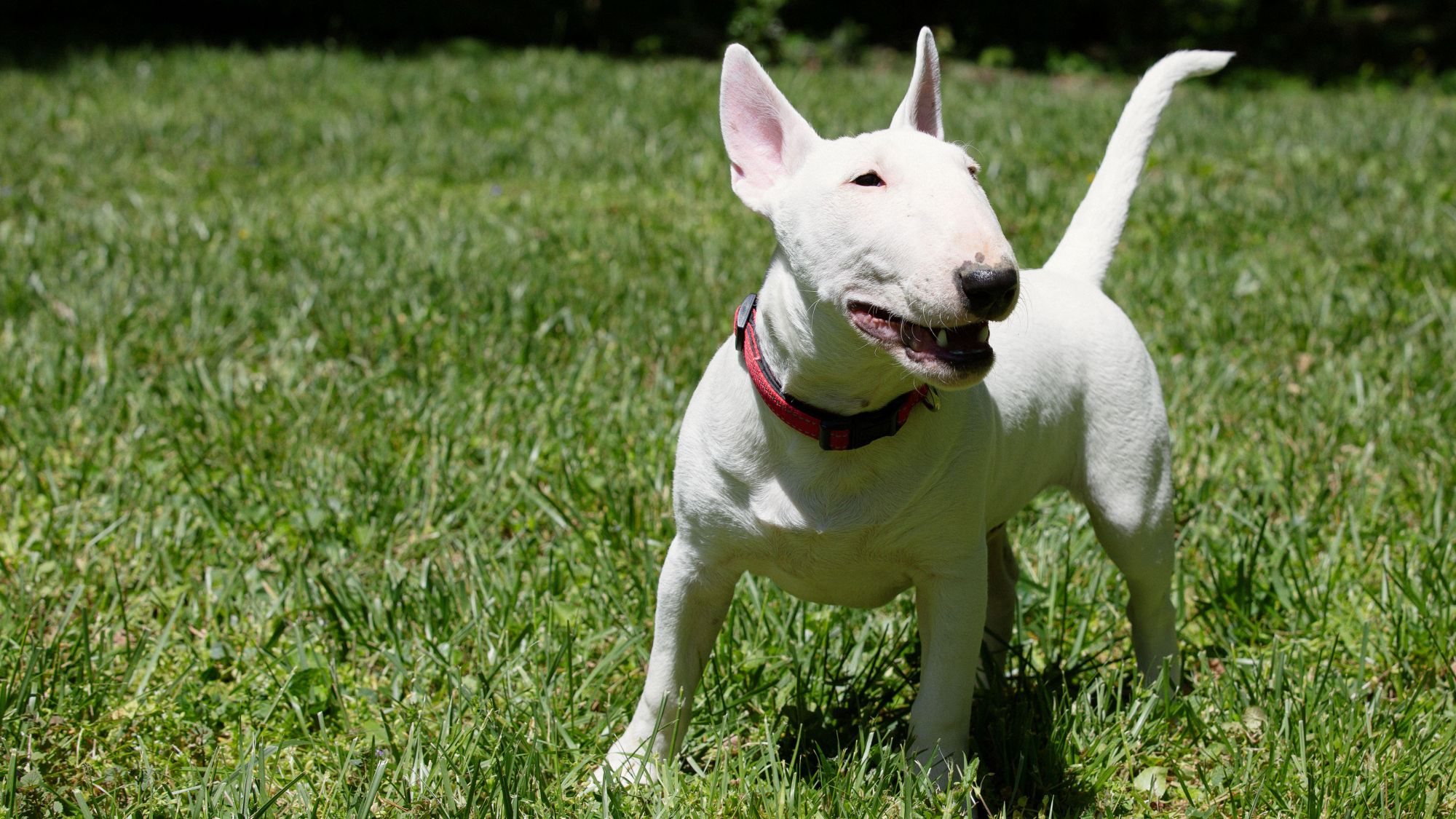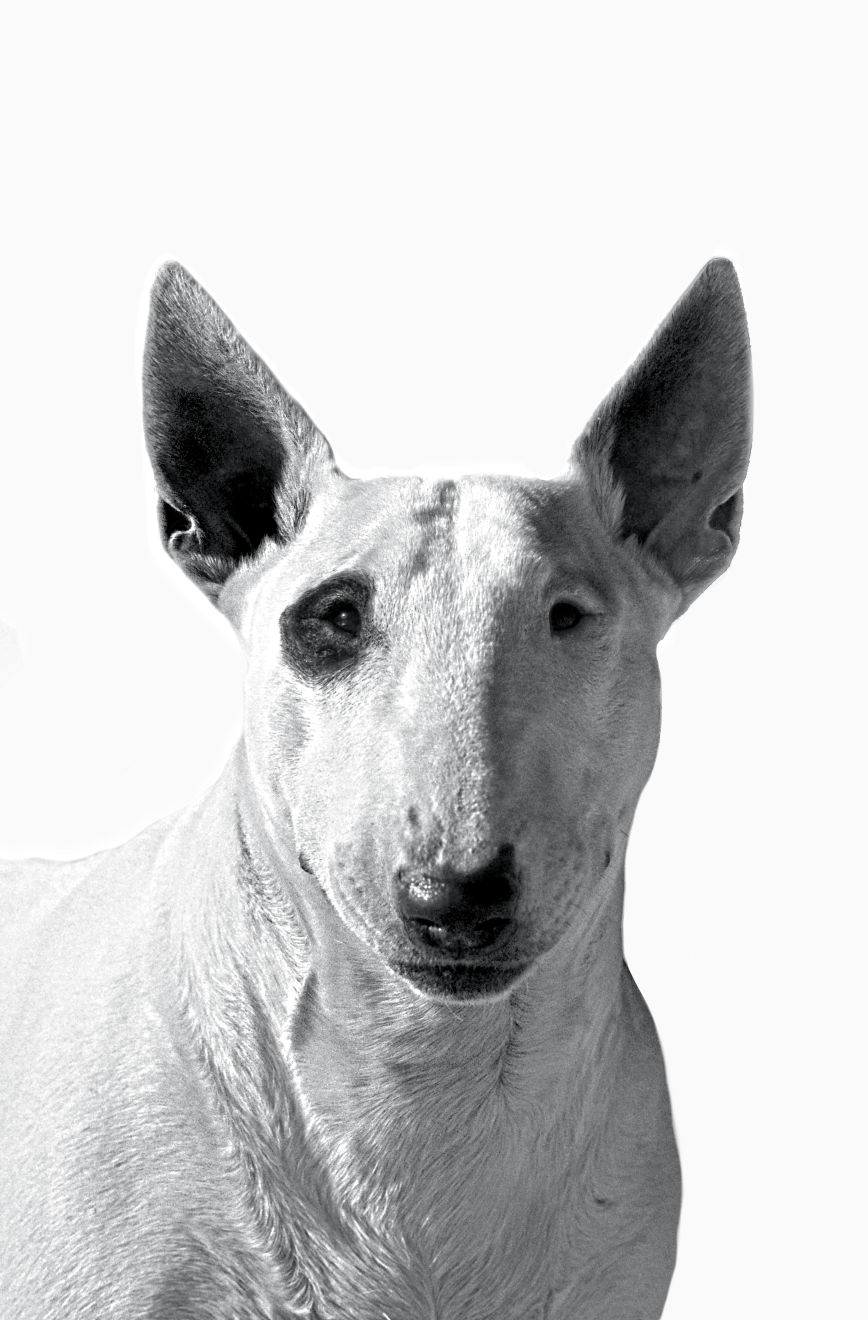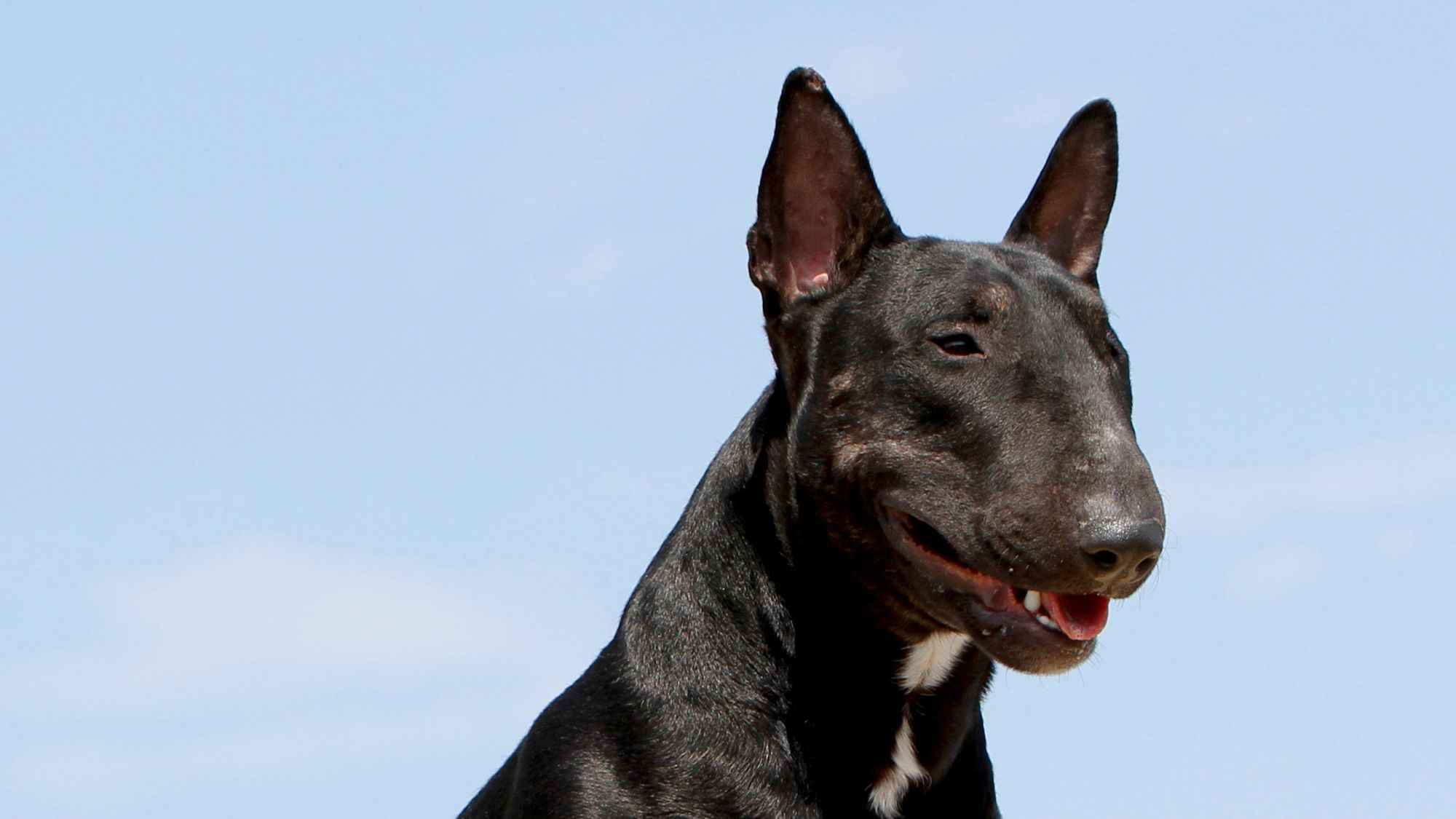Let's talk Bull Terriers
The Bull Terrier lives up to the canine moniker of ‘(wo)man’s best friend’. They welcome anyone and everyone with open paws, making them a faithful and affectionate companion. You will find the Bull Terrier wherever the action is, as they like to stay busy and as close as possible to their people. Their intelligence makes the Bull Terrier a fantastic playmate and with consistent training, the Bull Terrier is a welcome addition to the family unit, capable of getting on very well with children.
Official name: Bull Terrier
Other names: English Bull Terrier, Bully
Origins: United Kingdom
Drooling tendencies
1 out of 5Shedding Level
3 out of 5Energy level*
3 out of 5Compatibility with other pets
4 out of 5Warm weather?
4 out of 5Suited to apartment living
4 out of 5Family pet?*
5 out of 5Can be left alone
2 out of 5
| Male | Female |
|---|---|
| Height | Height |
| 21 - 22 in | 21 - 22 in |
| Weight | Weight |
| 50 - 70 lb | 50 - 60 lb |
| Life stages | |
|---|---|
| Puppy | Adult |
| 2 to 12 months | 1 to 7 years |
| Mature | Senior |
| 7 to 10 years | 10 years onwards |
| Baby | |
| Birth to 2 months | |
Drooling tendencies
1 out of 5Shedding Level
3 out of 5Energy level*
3 out of 5Compatibility with other pets
4 out of 5Warm weather?
4 out of 5Suited to apartment living
4 out of 5Family pet?*
5 out of 5Can be left alone
2 out of 5
| Male | Female |
|---|---|
| Height | Height |
| 21 - 22 in | 21 - 22 in |
| Weight | Weight |
| 50 - 70 lb | 50 - 60 lb |
| Life stages | |
|---|---|
| Puppy | Adult |
| 2 to 12 months | 1 to 7 years |
| Mature | Senior |
| 7 to 10 years | 10 years onwards |
| Baby | |
| Birth to 2 months | |

Tailored nutrition for your Bull Terrier
Get to know the Bull Terrier
All you need to know about the breed
There is never a dull moment with a Bull Terrier around. Friendly. High energy. Loyal. They are a charming breed, who also like to play the class clown from time to time. With their unique egg-shaped head, they have won hearts many times over.
Active types need only apply! Exercise for your Bull Terrier should be between 30 and 60 minutes per day, and they excel when given fun tasks such as flyball or agility exercises. The Bull Terrier suits a confident owner, who will be firm and constant in their approach to training, taking the breed’s stubborn streak in their stride. Overall, teaching your Bull Terrier should be a pleasant experience for both parties, as the breed learns quickly and likes to please their owners.
The Bull Terrier much prefers to be around people and does not do well if left to their own devices. Early socialization makes for a super sociable canine, who is great at being a guard dog, and feels comfortable in a crowd.
The Bull Terrier is always down to play, which makes them great company for older children who show them respect. Younger children however may find the breed a little too boisterous - he never means any harm but just gets over excited when the fun happens. However, if you’re looking for an affectionate and loving canine companion and enjoy a good amount of daily exercise, then the Bull Terrier may well be the breed for you.

Two facts about Bull Terriers
1. Mister Lonely
A Bull Terrier prefers company, so this is not the breed for you if work involves travel or long days away from home. If left to entertain themselves, they are likely to eat anything they can sink their teeth into. A Bull Terrier will not expect your undivided attention 24/7, they just love being around people! Social butterflies, if you will.
2. More exercise please
Exercising a Bull Terrier is not just physical, they also need their minds to stay sharp on a daily basis. Take your Bull Terrier for a jog or a long walk - always on a leash to prevent them wandering off - but also buy them interactive toys that will work their brain cells. The Bull Terrier will expend their energy in whatever way possible, so the more entertaining you make it for them, the more devoted they will be to you.

History of the breed
Let’s rewind to 1835, when the Bull Terrier first appeared on the scene. A cross between a Bulldog and an English Terrier (now extinct), the Bull Terrier was known for its strength.
In 1860, an Englishman named James Hinks set out to create a white coated Bull Terrier, which set a new trend. Suddenly the breed became the must-have companion of distinguished gentlemen throughout England. This led to them being nicknamed “White Cavalier”, because of their dignified manner towards people.
The Bull Terrier remains as sweet and friendly as ever - with a silly side to boot that they’re not afraid to reveal. The American Kennel Club (AKC) first registered the breed in 1885, with a Bull Terrier named Nellie II. In 1936, the colored Bull Terrier variety was officially recognised, and more recently, in 1992, the Miniature Bull Terrier was recorded as a separate breed
Much like his distant relatives, the American Staffordshire Terrier and the Staffordshire Bull Terrier, many still believe the Bull Terrier of today to be some sort of canine gladiator. Brave, yes. Likes to stay active, also yes. But in reality, the Bull Terrier makes for an affectionate and loyal companion - for life.
From head to tail
Physical characteristics of Bull Terriers
1.Head
2.Ears
3.Eyes
4.Coat
5.Body

Things to look out for
From specific breed traits to a general health overview, here are some interesting facts about your Bull Terrier
Skin type: sensitive
Bull Terriers are a pretty healthy breed in general, but one thing to look out for is sensitive skin, especially those with a white coat. The breed can also have contact allergies with dust, pollen or washing detergents. Keep an eye out for rashes or irritations during weekly brushing sessions and ask your veterinarian should you have any concerns. There are also long-term treatment options if necessary, to keep your Bull Terrier feeling good!
Spinning around
Young Bull Terriers (6 months +) can sometimes develop an obsession for chasing their tail. Often, this suggests that they are bored, in which case there’s a simple solution. More exercise, both physical and mental! Play a game with your Bull Terrier or distract them with a nice walk outside. If this doesn’t work, don’t go into a tailspin of your own. Consult your veterinarian should you have any concerns.
Tailored nutrition for Bull Terriers

When choosing food for a Bull Terrier, there are many factors to consider: their age, lifestyle, activity level, physiological condition, and health including potential sickness or sensitivities. Food provides energy to cover a dog’s vital functions, and a complete nutritional formula should contain an adjusted balance of nutrients to avoid any deficiency or excess in their diet, both of which could have adverse effects on the dog.
Strong Immune System
Supports the development of the puppy's healthy immune system with the inclusion of clinically proven antioxidants, including vitamins E and C.
Brain Development
Enriched with DHA, an omega-3 fatty acid that is scientifically proven to support the puppy's brain development.
Microbiome Support
Combination of prebiotics & highly digestible proteins to help promote a healthy balance of intestinal bacteria for digestive health.

The main nutritional goals for adult Bull Terriers are:
Body Condition
Helps maintain ideal weight and muscle mass with optimal levels of protein.
Healthy Immune System
Clinically proven antioxidants (vitamins C and E) and prebiotics for a healthy gut and immune system.
Healthy Digestion
Easy-to-digest proteins, vitamins & minerals, and a blend of fibers for optimal nutrient absorption.

At around 7 years old, Bull Terriers start facing the first signs of aging. A formula enriched with antioxidants will help maintain their vitality, and specific nutrients, such as chondroitin and glucosamine, will help maintain healthy bones and joints. Aging is also accompanied by the modification of digestive capacities and particular nutritional requirements, so food for older Bull Terriers should have the following characteristics:
Body Condition
Helps maintain ideal weight and muscle mass with optimal levels of protein.
Vitality Support
Supports heart, kidney and brain health in first stage of aging.
Healthy Immune System
Clinically proven antioxidants (vitamins C and E) and prebiotics for a healthy gut and immune system.

Caring for your Bull Terrier
Exercise, grooming and training.
7/7
All about Bull Terriers
Yes, 100%. The Bull Terrier is an affectionate dog, who is capable of being equally devoted to all family members. The Bull Terrier also has a mischievous side, which makes them an entertaining companion, and they’re content to tire themselves out playing with older children. Teaching the Bull Terrier good social skills from when they are a puppy will result in a placid companion who is loyal until the very end.
When it comes to protecting the ones that they love, the Bull Terrier is top of the class. The breed’s muscular physique is often enough of a deterrent for wannabe burglars, especially when coupled with their loud bark, which the Bull Terrier rarely uses. Word of warning, the Bull Terrier’s natural protective instincts should not be developed any further - keep the breed a lover, not a fighter.
Suggested Breeds
Read more on this topic
Sources
- Veterinary Centers of America https://vcahospitals.com/;
- Royal Canin Dog Encyclopaedia. Ed 2010 and 2020
- Banfield Pet Hospital https://www.banfield.com/
- Royal Canin BHN Product Book
- American Kennel Club https://www.akc.org/
Like & share this page